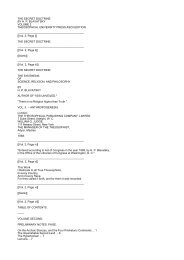You also want an ePaper? Increase the reach of your titles
YUMPU automatically turns print PDFs into web optimized ePapers that Google loves.
Plates VII.-X.<br />
<strong>the</strong> words <strong>of</strong> <strong>the</strong> god Tmu come to pass. "I am <strong>the</strong> god Tmu in [my] rising;[2] I am <strong>the</strong> only One. I came<br />
into existence in Nu. (6) I am Ra who rose in <strong>the</strong> beginning. [He hath ruled that which he made.][3]"<br />
(7) Who <strong>the</strong>n is this? It is Ra who rose for <strong>the</strong> first time in <strong>the</strong> city <strong>of</strong> (8) Suten-henen[4] [crowned][5] as<br />
a king in [his] rising.[6] The pillars <strong>of</strong> Shu[7] were not as yet created, when he was upon <strong>the</strong> (9) high<br />
place <strong>of</strong> him who is in Khemennu.[8]<br />
"I am <strong>the</strong> great god who gave birth to himself, even Nu, (10) [who] created his name Paut Neteru[9] as<br />
god."<br />
Who <strong>the</strong>n (11) is this? It is Ra, <strong>the</strong> creator <strong>of</strong> <strong>the</strong> name[s] <strong>of</strong> his limbs, which came into being (12) in <strong>the</strong><br />
form <strong>of</strong> <strong>the</strong> gods in <strong>the</strong> train <strong>of</strong> Ra.<br />
"I am he who is not driven back among <strong>the</strong> gods."<br />
[1. For accounts <strong>of</strong> <strong>the</strong> way in which draughts were played by <strong>the</strong> Egyptians, see Birch, in Revue Archéologique, 1864, p.<br />
56 ff.; Birch, in Aeg. Zeitschrift, 1866, p. 97; Birch, in Trans. Boy. Son Literature, New Series, vol. ix., p. 256; and<br />
Falkner, Oriental Games, London, 1892. The draught-board <strong>of</strong> <strong>the</strong> ancient Egyptians is <strong>of</strong>ten a rectangular wooden box,<br />
<strong>the</strong> top divided into squares, containing a drawer in which <strong>the</strong> men are kept (British Museum, No. 21,576). Draught-boards<br />
were also made <strong>of</strong> blue glazed faïence, and bone or ivory (British Museum, No. 21,577). The draughtsmen n are <strong>of</strong> wood,<br />
bone, ivory, glazed faïence, or stone, and have at times <strong>the</strong> heads <strong>of</strong> lions 1) (British Museum, Nos. 13,417, 21,580,<br />
21,581); jackals (British Museum, Nos. 604b, 24,660-66); and <strong>of</strong> <strong>the</strong> god Bes (British Museum, Nos. 6413c, 24,667-75).<br />
No. 6414a is inscribed with <strong>the</strong> prenomen <strong>of</strong> Necho II.<br />
2, I.e., <strong>the</strong> Sun-god when he sets and rises.<br />
3. Supplied from <strong>the</strong> Papyrus <strong>of</strong> Nebseni. See British Museum papyrus No. 9900; Naville, Todtenbuch, Bd. II., Pl. xxxi.<br />
4 See supra, p. 273, note 3.<br />
5. Adding ### or ### from <strong>the</strong> variant readings given by Naville.<br />
6. Some papyri read Unnu; on this town, see Brugsch, Dict. Géog., p. 146.<br />
7. Shu was <strong>the</strong> son <strong>of</strong> Ra and Hathor and <strong>the</strong> twin-bro<strong>the</strong>r <strong>of</strong> Tefnut. He typified <strong>the</strong> sunlight, and separated <strong>the</strong> earth from<br />
<strong>the</strong> sky, which he established and supported. For a drawing <strong>of</strong> Shu and his four supports, see Lanzone, Dizionario, tav.<br />
385.<br />
8. See Brugsch, Dict. Géog., p. 749.<br />
9. I.e., " substance <strong>of</strong> <strong>the</strong> gods."]<br />
{p. 282}<br />
(13) Who <strong>the</strong>n is this? It is Tmu in his disk, or (as o<strong>the</strong>rs say), It is Ra in (14) his rising in <strong>the</strong> eastern<br />
horizon <strong>of</strong> heaven.<br />
"I am Yesterday; I know (15) Tomorrow."<br />
Who <strong>the</strong>n is this? Yesterday is Osiris, and (16) Tomorrow is Ra, on <strong>the</strong> day when he shall destroy <strong>the</strong><br />
(17) enemies <strong>of</strong> Neb-er-tcher, and when he shall stablish as prince and ruler (18) his son Horus, or (as<br />
o<strong>the</strong>rs say), on <strong>the</strong> day when we commemorate <strong>the</strong> festival (19) <strong>of</strong> <strong>the</strong> meeting <strong>of</strong> <strong>the</strong> dead Osiris with his<br />
fa<strong>the</strong>r Ra, and when <strong>the</strong> battle <strong>of</strong> <strong>the</strong> (20) gods was fought in which Osiris, lord <strong>of</strong> Amentet, was <strong>the</strong><br />
leader.<br />
http://www.sacred-texts.com/egy/ebod/ebod18.htm (6 <strong>of</strong> 14) [8/10/2001 11:27:39 AM]

















